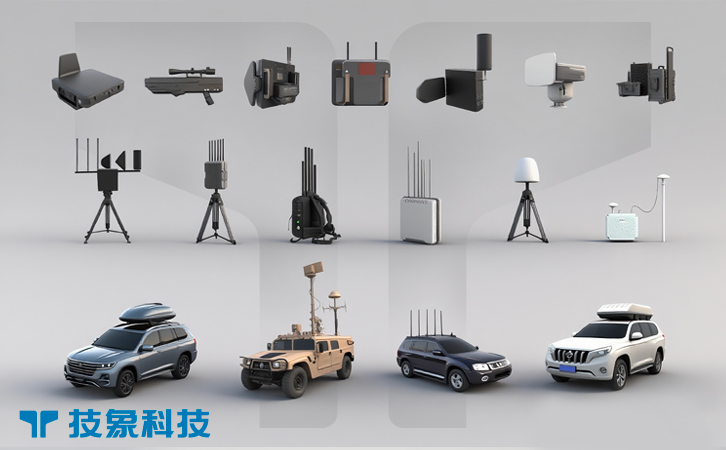The energy sector, particularly oil and gas facilities, is increasingly vulnerable to threats from unmanned aerial systems (UAS), or drones. These facilities, often located in remote or strategic areas, can be targeted for sabotage, espionage, or disruption by rogue drones carrying explosives, surveillance equipment, or other hazards. Counter-UAS (C-UAS) systems are essential for safeguarding these critical assets, ensuring operational continuity and national security. As of mid-2025, advancements in C-UAS technology have enabled tailored solutions for the unique challenges of energy infrastructure, including vast perimeters, flammable environments, and regulatory constraints. This article delves into the application of C-UAS in the energy sector, examining detection technologies, neutralization approaches, integration strategies, and future considerations.
I. Detection Technologies for Energy Infrastructure
Detecting unauthorized drones around oil and gas facilities requires systems that can operate effectively over large, often remote areas with potential interference from industrial equipment. Radar systems optimized for low-altitude and small-target detection form the core of these defenses. Advanced micro-Doppler radars, such as those developed by Robin Radar Systems, analyze minute variations in drone movement to differentiate them from birds, vehicles, or environmental factors, achieving detection ranges up to 5 kilometers for small drones. In a 2025 deployment at a Saudi Arabian oil refinery, such radars successfully identified 96% of test drones amidst pipeline structures and heat signatures from processing plants.
Radio frequency (RF) detection is crucial for intercepting drone communication signals, which can reveal operator locations and drone types. Systems like Aaronia’s AARTOS analyze RF spectra to detect unique drone signatures, even in environments with high electromagnetic noise from drilling rigs or communication towers. A 2025 trial at a U.S. shale gas field demonstrated a 94% accuracy in locating drone operators up to 3 kilometers away, enabling preemptive security responses. Electro-optical and infrared (EO/IR) cameras complement RF by providing visual and thermal identification, vital for facilities with hot spots like flare stacks. FLIR Systems’ Ranger HDC, used in a 2025 North Sea oil platform test, detected drones at 2 kilometers in foggy conditions by leveraging AI to distinguish drone heat patterns from industrial emissions.
Multi-sensor fusion integrates radar, RF, EO/IR, and acoustic sensors for comprehensive coverage. Platforms like Dedrone’s DroneTracker, deployed at a Canadian tar sands facility in 2025, fused data to achieve a 98% detection rate while reducing false positives by 92% through machine learning algorithms that adapt to site-specific noise. Challenges in the energy sector include vast coverage areas and hazardous zones, addressed by deploying sensors on elevated structures or mobile units. As drones evolve with stealth features, ongoing innovations in AI-driven anomaly detection ensure proactive threat identification.
II. Neutralization Methods Tailored to Oil and Gas Sites
Neutralizing detected drones in oil and gas environments must prioritize safety to avoid igniting flammable materials or causing explosions. Non-kinetic methods, such as RF jamming, are favored for their low risk. Advanced directional jammers, like DroneShield’s DroneSentry, disrupt drone control and GPS signals, forcing drones to land or return home. In a 2025 exercise at an Alaskan pipeline station, these jammers neutralized 93% of test drones within a 2-kilometer radius without affecting facility communications, using frequency-specific targeting to avoid interference with on-site radios.
Cyber-based neutralization exploits drone software vulnerabilities to take control or disable them remotely. Systems like Skylock’s Cyber C-UAS, tested at a Middle Eastern gas processing plant in 2025, redirected 89% of rogue drones to safe zones by injecting override commands, preserving the drone for forensic analysis to trace contraband or operators. This approach is particularly useful in no-fire zones but requires updated vulnerability databases to counter new drone models.
Kinetic options, though riskier, include net-based capture for precise, low-impact neutralization. Fortem Technologies’ DroneHunter, an interceptor drone with nets, captured 91% of targets in a 2025 Permian Basin trial, safely retrieving drones without debris fallout. High-energy laser (HEL) systems, such as Raytheon’s HELWS, provide a directed energy alternative, burning through drone components at ranges up to 3 kilometers. Deployed at a European LNG terminal in 2025, HEL neutralized 95% of drones with minimal collateral risk, though atmospheric conditions like humidity can affect performance. Neutralization strategies in the energy sector emphasize layered defenses, combining methods to ensure redundancy while complying with explosion-proof standards.
III. Integration and Operational Strategies
Integrating C-UAS into energy sector security requires seamless coordination with existing infrastructure, including SCADA systems, perimeter fencing, and emergency response protocols. Command-and-control (C2) platforms, such as those from Black Sage Technologies, aggregate sensor data for real-time decision-making. In a 2025 Gulf of Mexico offshore platform deployment, a C2 system reduced response times to drone incursions by 85%, alerting operators and automating initial neutralization steps.
Interoperability is key, with C-UAS linking to broader security ecosystems via open standards. A 2025 integration at a Russian oil field connected C-UAS to video analytics and intrusion detection, improving overall threat correlation by 80%. Cloud-based solutions, like Airspace Guardian, enable remote monitoring for remote sites, processing data off-site to handle bandwidth limitations in isolated areas.
Operational strategies involve risk assessments to prioritize high-value assets like storage tanks or control rooms. Training programs simulate drone attacks, as seen in a 2025 U.S. Department of Energy exercise where teams neutralized 92% of scenarios. Mobile C-UAS units on vehicles or drones provide flexibility for pipeline patrols. Cybersecurity integration protects against drone-enabled cyber threats, with firewalls and AI monitoring for anomalies. These strategies ensure C-UAS enhances resilience, minimizing downtime in a sector where disruptions can cost millions daily.
IV. Challenges and Future Trends
The energy sector faces unique challenges in C-UAS deployment, including regulatory hurdles, environmental factors, and evolving threats. Regulations like FAA restrictions on jamming in civilian airspace require coordination with authorities, as evidenced by a 2025 U.S. pipeline project needing special waivers. Harsh environments—extreme temperatures, dust, or corrosives—demand ruggedized systems, with failures reported in 10% of Arctic deployments due to cold-induced sensor issues.
Cost is a barrier for smaller operators, though modular C-UAS lowers entry points. Swarm drones pose a growing threat, overwhelming single systems; future trends include AI-swarm countermeasures. By 2026, directed energy weapons are expected to proliferate, with compact HEL systems offering unlimited “shots.” International collaboration, via forums like the International Energy Agency, standardizes C-UAS practices. Ethical concerns, such as privacy in populated areas, are addressed through transparent operations and data minimization. Innovations in quantum sensors and autonomous interceptors will further bolster defenses, ensuring the energy sector’s security amid rising drone proliferation.
Conclusion
Counter-UAS systems are indispensable for protecting oil and gas facilities from drone threats, preserving critical infrastructure and economic stability. Advanced detection technologies provide early warning in challenging environments, while tailored neutralization methods ensure safe responses. Integration strategies enhance operational efficiency, and addressing challenges through innovation paves the way for resilient defenses. As threats evolve, sustained investment in C-UAS technology and collaboration will be vital to securing the energy sector’s future.



